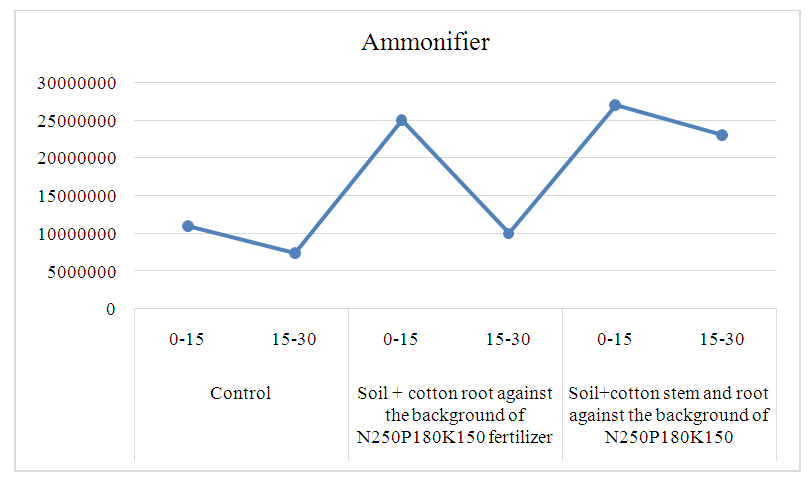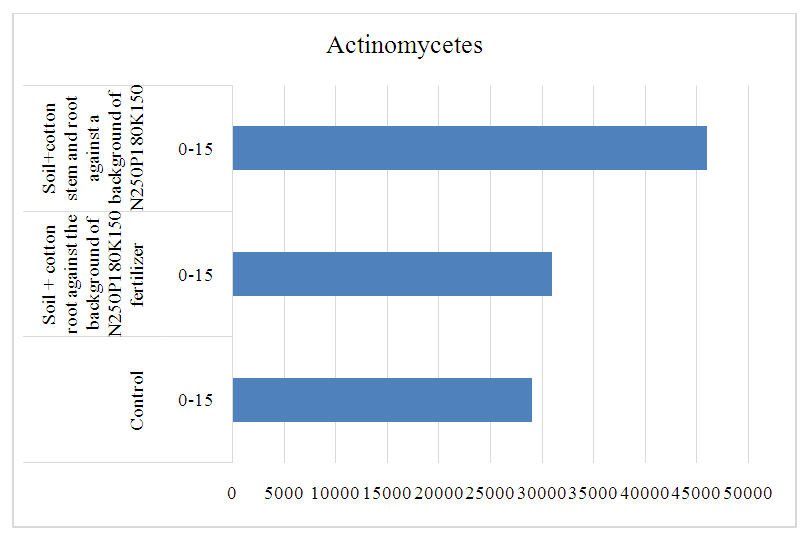-
Paper Information
- Paper Submission
-
Journal Information
- About This Journal
- Editorial Board
- Current Issue
- Archive
- Author Guidelines
- Contact Us
International Journal of Genetic Engineering
p-ISSN: 2167-7239 e-ISSN: 2167-7220
2025; 13(6): 111-115
doi:10.5923/j.ijge.20251306.05
Received: May 13, 2025; Accepted: May 29, 2025; Published: Jun. 7, 2025

Influence of Plant Residue Composition on the Humus Condition and Biological Activity of Irrigated Soils
Sayyorakhon Yunusova1, Saidjon Sidiqov2, Dilafruz Maxkamova3
1PhD Student in Soil Science at the National University of Uzbekistan, University Street 4, Tashkent, Uzbekistan
2Candidate of Agricultural Sciences, Professor, National University of Uzbekistan named after Mirzo Ulugbek, Tashkent, Uzbekistan
3Associate Professor, Department of Soil Science, National University of Uzbekistan, University Street 4, Tashkent, Uzbekistan
Correspondence to: Sayyorakhon Yunusova, PhD Student in Soil Science at the National University of Uzbekistan, University Street 4, Tashkent, Uzbekistan.
| Email: |  |
Copyright © 2025 The Author(s). Published by Scientific & Academic Publishing.
This work is licensed under the Creative Commons Attribution International License (CC BY).
http://creativecommons.org/licenses/by/4.0/

The article presents information on the influence of composting the soil with plant residues of cotton, alfalfa, wheat, and ephemeral plants on the humus content and biological activity, as well as the number of microorganisms in old- irrigated typical sierozem. Positive results regarding the humus state and biological activity were obtained when composting the soil with above-ground and underground cotton biomass against the background of N250P180K150 mineral fertilizer rates.
Keywords: Soil, Plant residues, Composting, Humus, Fertility, Biological activity, Ammonifiers, Phosphorus-decomposing bacteria, Oligonitrophiles, Azotobacter, Actinomycetes, Microscopic fungi
Cite this paper: Sayyorakhon Yunusova, Saidjon Sidiqov, Dilafruz Maxkamova, Influence of Plant Residue Composition on the Humus Condition and Biological Activity of Irrigated Soils, International Journal of Genetic Engineering, Vol. 13 No. 6, 2025, pp. 111-115. doi: 10.5923/j.ijge.20251306.05.
Article Outline
1. Introduction
- Improving soil properties, enhancing biological activity, and increasing fertility through organic matter enrichment are essential for achieving abundant and high-quality crop yields. However, the application of traditional organic fertilizers is currently limited, necessitating the use of alternative resources to improve the humus content and biological activity of soils. In this context, plant residues and certain types of industrial waste serve as valuable substitutes for organic fertilizers. These materials are rich in organic compounds and contain essential nutrients required for plant growth. Globally, the total volume of crop residues amounts to approximately 2,445.2 million tons [9].In natural ecosystems, humus formation represents a key component of the biomass cycle. As noted by L.N. Aleksandrova, humic substances, especially humic acids, are synthesized during this process and play a vital role in maintaining soil health [1].According to research conducted by Stanislav Tormaa, Jozef Vilček, Tomáš Lošák, and Stanislav Kužel, certain crops contribute significantly to soil organic matter. For example, in the top 30 cm of soil, winter rye and sunflower residues can contribute over 8 tons of biomass per hectare, whereas root crops such as sugar beets, potatoes, and peas contribute less than 3 tons of dry biomass per hectare [12].The processes of mineralization of plant and animal residues, nutrient cycling, and replenishment of soil carbon and nitrogen reserves are intricately linked to microbial activity. Microorganisms play a crucial role in enriching the soil with biologically active compounds. The intensity of microbiological processes in the soil is influenced by the availability of organic matter, temperature, soil texture, water-air balance, topography, erosion susceptibility, and agricultural practices, including fertilization [1,6,7,10].Microorganisms facilitate the decomposition of organic matter within the soil. A diverse array of microbial life inhabits the soil, including bacteria, actinomycetes, fungi, algae, yeasts, lichens, and protozoa. Their population density can reach millions to billions per gram of soil. Soil biological activity significantly affects its properties, functioning, and overall fertility. Therefore, assessing soil microbiological activity is critical for evaluating soil quality, fertility status, and for implementing effective soil management strategies [2,8,9].In light of these considerations, the present research was undertaken to examine the impact of plant biomass on the quantity and biological activity of soil humus.
2. Analysis of the References
- According to researchers, autumn-winter intermediate crops play a significant role in enriching the soil with organic matter and essential nutrients. The stubble and root residues left behind by these crops undergo various biochemical transformations under the influence of soil processes, including microbial activity. These residues are gradually converted into nutrient-rich compounds essential for plant growth, thereby enhancing the productivity of subsequent crops and contributing to long-term soil fertility [7,8,11].A review of the scientific literature reveals that the greatest biomass production occurs in forest ecosystems, where 4 to 9 tons of plant residues per hectare accumulate annually in the form of dry matter. In contrast, natural herbaceous vegetation in arid zones, such as deserts, contributes significantly less—only about 1 to 2 tons of dry biomass per hectare per year. Cultivated agricultural crops contribute the least amount of organic residues to the soil, as most of their above-ground biomass is removed during harvesting and is not returned to the soil for humus formation [7,8,11,12,13].One of the most important microbial groups involved in soil formation and fertility enhancement is the ammonifying group of microorganisms. Through the decomposition of proteins by aerobic and anaerobic bacteria, actinomycetes, and fungi, nitrogen is released primarily in the form of ammonia (NH₃), making it accessible for plant uptake. This ammonification process is a key phase in the nitrogen cycle and is vital for sustaining plant nutrition [2,4].Ammonification refers to the microbial breakdown of nitrogen-containing organic compounds, resulting in the formation of gaseous ammonia or ammonium ions. This process is driven by several active groups of soil microorganisms, including Gram-positive spore-forming aerobic bacteria (e.g., Bacillus, Clostridium), non-spore-forming actinobacteria (Arthrobacter, Mycobacterium, Micrococcus), and Gram-negative genera such as Pseudomonas and Proteus. These organisms play a crucial role in the mineralization of nitrogenous organic matter and the decomposition of complex biological materials.Among the most widespread soil microorganisms are actinomycetes, which contribute significantly to soil fertility. These organisms utilize both organic and mineral nitrogen forms and are capable of degrading a wide variety of substrates, including mono-, di-, and polysaccharides, animal and plant fats, soil humus, and even chitin. Actinomycetes are also known for their resistance to high salt concentrations, and certain species are capable of fixing atmospheric nitrogen, further contributing to soil nutrient enrichment [2,5].Microscopic fungi also play a key role in soil health and fertility. They actively participate in the decomposition of plant residues, and their abundance varies depending on soil cultivation practices and seasonal dynamics.Indeed, almost no biogeochemical process in the soil occurs without the participation of microorganisms. These processes are strongly influenced by environmental conditions such as relief, climate, parent rock material, vegetation, and the chemical properties of the soil [2,4,9].Studies also indicate a close dependence of microbial population dynamics on environmental factors. These include changes in microbial biomass productivity, fluctuations in microbial community composition, and reductions in the relative abundance of certain microbial groups within the total biomass [5].In recent years, the use of intensive agro-technologies—particularly the incorporation of composted plant biomass and the application of organo-mineral fertilizers—has proven highly effective in improving crop yields and promoting sustainable soil management.
3. Research Methodology
- The research was conducted under field conditions using methods adopted in long-irrigated typical sierozem soils [6,13]. To determine the influence of composting of various plant residues on the humus content and microbiological activity of the soil, a micro-experiment was conducted on typical sierozem soils.The experiment was conducted in 3 variants with 4 repetitions: 1st variant - control; Variant 2 - soil + cotton root against the background of N250P180K150; Variant 3 - soil + cotton stem and roots against the background of N250P180K150.In the first year of the research, cotton was sown on the experimental plot, the control variant was left unused. At the end of the growing season, the soils of the experimental variant were plowed together with the roots, stems, and roots of cotton, while the control variant was plowed without adding any plant residues. In the second year, cotton was sown in all variants of the field experiment, and the amount of humus and the number of microorganisms in the soils were determined during the growing season.The humus content in the plowed and subsoil horizons was determined by the Tyurin method. To determine the quantity of the main physiological groups in the soil, soil samples were taken from a depth of 0-15, 15-30 cm. Soil microorganisms, including ammonifying bacteria - GPA (meat peptone agar) medium, phosphorus-decomposing bacteria - Pikovsky medium, oligonitrophiles - ESHBI medium, micromycetes and actinomycetes - Chapeka solid medium were studied. A suspension was prepared from the soil sample taken for microbiological analysis.
4. Analysis and Results
- According to the obtained results, a significant difference in humus content was observed in the soils of the experimental variant during the year (Table 1). When plowing the stem and root parts of cotton with the soil, the amount of humus in the soil increased and a positive balance was observed. In the soils of the control variant, the humus content decreased, and a negative balance arose.
|
 | Figure 1. Changes in ammonifying bacteria according to the conducted experiment |
 | Figure 2. According to the results of the studied experiment, the content of actinomycetes in the 0-15 cm layer was determined |
5. Conclusions
- Based on the conducted research in field conditions, it can be concluded that plowing the soil with cotton stems and roots positively affects the process of humus formation, but a negative balance is maintained with a humus deficiency of 0.067% in the soil.According to the research results, as a result of studying the microflora of soil samples, the number of ammonifying bacteria and oligonitrophilic microorganisms from the main physiological group of microorganisms in all samples was 1-2 orders of magnitude less than the norm, phosphorus-decomposing bacteria and azotobacteria were not found at all, actinomycetes were found only in samples taken from the 0-15 cm layer of the control variant, soil+cotton root composted against the background of N250P180K150 fertilizer, and soil+cotton stem and root composted against the background of N250P180K150 variant 3, and was 1-2 orders of magnitude less than the norm, Micromycetes were found only in the 2nd variant, composted against the background of N250P180K150 fertilizer with soil + cotton root, and in the 3rd variant, composted against the background of N250P180K150 fertilizer with soil + cotton stem and root, and exceeded the norm by 1 order. It was established that micromycetes belong to the genera Mucor and Fusarium. Bacillus mycoides species were found. The highest number of microorganisms was observed in the 3rd variant with soil + composting of cotton stems and roots against the background of N250P180K150.
 Abstract
Abstract Reference
Reference Full-Text PDF
Full-Text PDF Full-text HTML
Full-text HTML